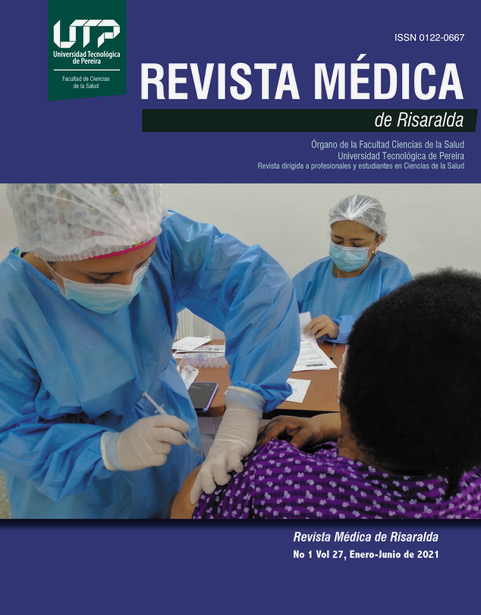Mirizzi syndrome type V: laparoscopic management
DOI:
https://doi.org/10.22517/25395203.24657Keywords:
Mirizzi Syndrome, Cholelithiasis, Cholangitis, LaparoscopyAbstract
Introduction: Mirizzi's syndrome is an infrequent complication of biliary lithiasic disease, with an incidence of less than 1% in developed countries, being even less frequent the type V variant. Current literature disagrees on the management of this condition, stating that laparoscopic surgery is not safe as a standard procedure.
Clinical Case: We present the case of Mirizzi’s Syndrome in an 80-year-old man, which is referred to the emergency department for suspicion of sepsis of abdominal origin, with ultrasound study of cholelithiasis, pneumoobilia and dilation of the bile ducts. Retrograde endoscopic cholangiopancreatography was performed with technical impossibility for the mobilization and extraction of large-size stones, resorting to exploration through laparoscopic technique, obtaining satisfactory results.
Conclusion: It is necessary to emphasize that the type of Mirizzi syndrome, the patient's characteristics and the surgeon's experience directly influence the treatment modality, its complications and/or success rates. In the present case, the experience of the main author in the management of minimally invasive procedures and the consideration of reducing the risk of complications such as infections in a fragile patient, were the factors that influenced the decision for laparoscopic intervention.
Downloads
References
Valderrama-Treviño AI, Granados-Romero JJ, Espejel-Deloiza M, Chernitzky-Camaño J, Barrera Mera B, Estrada-Mata AG, et al. Updates in Mirizzi syndrome. HepatoBiliary Surg Nutr. 2017; 6(3):170–8.
Jones MW, Ferguson T. Mirizzi Syndrome. 2021 Feb 8. In: StatPearls [Internet]. Treasure Island (FL): StatPearls Publishing; 2021 Jan–. PMID: 29494098.
Beltrán MA. Mirizzi syndrome: History, current knowledge and proposal of a simplified classification. World J Gastroenterol. 2012; 18(34):4639–50.
Chen H, Siwo EA, Khu M, Tian Y. Current trends in the management of Mirizzi Syndrome: A review of literature. Medicine (Baltimore). 2018 Jan;97(4):e9691. https://10.1097/MD.0000000000009691.
Rodríguez Carolina AG. El síndrome de compresión biliar extrínseca benigna o síndrome de Mirizzi: experiencia de cinco años en el Hospital de San José. Rev Colomb Cirugía. 2008; 23:6-11.
Lee KF. Mirizzi syndrome: a new approach to an old problem. Hepatobiliary Surg Nutr. 2018; 7(1):56-57.
Kimura J, Takata N, Lefor AK, Kanzaki M, Mizokami K. Laparoscopic subtotal cholecystectomy for Mirizzi syndrome: A report of a case. Int J Surg Case Rep. 2019; 55:32-34.
Csendes A, Muñoz C, Albán M. Síndrome de Mirizzi - Fístula colecistobiliar, una nueva clasificación. Rev Chil Cir. 2007; 59(Suppl):63–64.
Beltran MA, Csendes A, Cruces KS. The relationship of Mirizzi syndrome and cholecystoenteric fistula: Validation of a modified classification. World J Surg. 2008; 32(10):2237–43.
Al-Akeely MHA, Alam MK, Bismar HA, Khalid K, Al-Teimi I, Al-Dossary NF. Mirizzi syndrome: Ten years experience from a teaching hospital in Riyadh. World J Surg. 2005; 29(12):1687–92.
Borz-Baba C, Levy DA, Cohen ME. Post-Cholecystectomy Mirizzi Syndrome: A Case Report and Review of the Literature. Am J Case Rep. 2019; 20:1290-1298.
Erben Y, Benavente-Chenhalls LA, Donohue JM, Que FG, Kendrick ML, Reid-Lombardo KM, et al. Diagnosis and treatment of Mirizzi syndrome: 23-year mayo clinic experience. J Am Coll Surg. 2011; 213(1):114–9.
Bo LI, Xun LI, Wen-ce Z, Ming-yan HE, Wen-bo M, Lei Z, et al. Effect of endoscopic retrograde cholangiopancreatography combined. 2013; 126(18):3515–8.
Reverdito R, De Moricz A, De Campos T, Pacheco Júnior AM, Silva RA. Síndrome de Mirizzi graus III e IV: Tratamento cirúrgico. Rev Col Bras Cir. 2016; 43(4):243–7.
Yetişir F, Şarer AE, Acar HZ, Parlak O, Basaran B, Yazıcıoğlu O. Laparoscopic Resection of Cholecystocolic Fistula and Subtotal Cholecystectomy by Tri-Staple in a Type V Mirizzi Syndrome. Case Reports Hepatol. 2016; 2016:1–4.
Alemi F, Seiser N, Ayloo S. Gallstone Disease: Cholecystitis, Mirizzi Syndrome, Bouveret Syndrome, Gallstone Ileus. Surg Clin North Am. 2019; 99(2):231-244.
Yuan H, Yuan T, Sun X, Zheng M. A Minimally Invasive Strategy for Mirizzi Syndrome Type II: Combined Endoscopic with Laparoscopic Approach. Surg Laparosc Endosc Percutaneous Tech. 2016; 26(3):248–52.
Xu XQ, Hong T, Li BL, Liu W, He XD, Zheng CJ. Mirizzi syndrome: Our experience with 27 cases in PUMC Hospital. Chinese Med Sci J. 2013; 28(3):172–7.
Clemente G, Tringali A, De Rose A, Panettieri E, Murazio M, Nuzzo G, et al. Mirizzi Syndrome: Diagnosis and Management of a Challenging Biliary Disease. Can J Gastroenterol Hepatol. 2018; 2018:6962090.
Seara Costa R, Vieira F, Costa JM, Ferreira A. Mirizzi syndrome: when the gallbladder meets bile ducts. Rev Esp Enferm Dig. 2019; 111(6):481-482.
Downloads
-
Vistas(Views): 626
- PDF (Español (España)) Descargas(Downloads): 436
- PDF Descargas(Downloads): 221
Published
How to Cite
Issue
Section
License
Cesión de derechos y tratamiento de datos
La aceptación de un artículo para su publicación en la Revista Médica de Risaralda implica la cesión de los derechos de impresión y reproducción, por cualquier forma y medio, del autor a favor de Facultad de Ciencias de la Salud de la Universidad Tecnológica de Pereira. 1995-2018. Todos los derechos reservados ®
por parte de los autores para obtener el permiso de reproducción de sus contribuciones. La reproducción total o parcial de los trabajos aparecidos en la Revista Médica de Risaralda, debe hacerse citando la procedencia, en caso contrario, se viola los derechos reservados.
Asimismo, se entiende que los conceptos y opiniones expresados en cada trabajo son de la exclusiva responsabilidad del autor, sin responsabilizarse ni solidarizarse, necesariamente, ni la redacción, ni la editorial.
Es responsabilidad de los autores poder proporcionar a los lectores interesados copias de los datos en bruto, manuales de procedimiento, puntuaciones y, en general, material experimental relevante.
Asimismo, la Dirección de la revista garantiza el adecuado tratamiento de los datos de carácter personal



